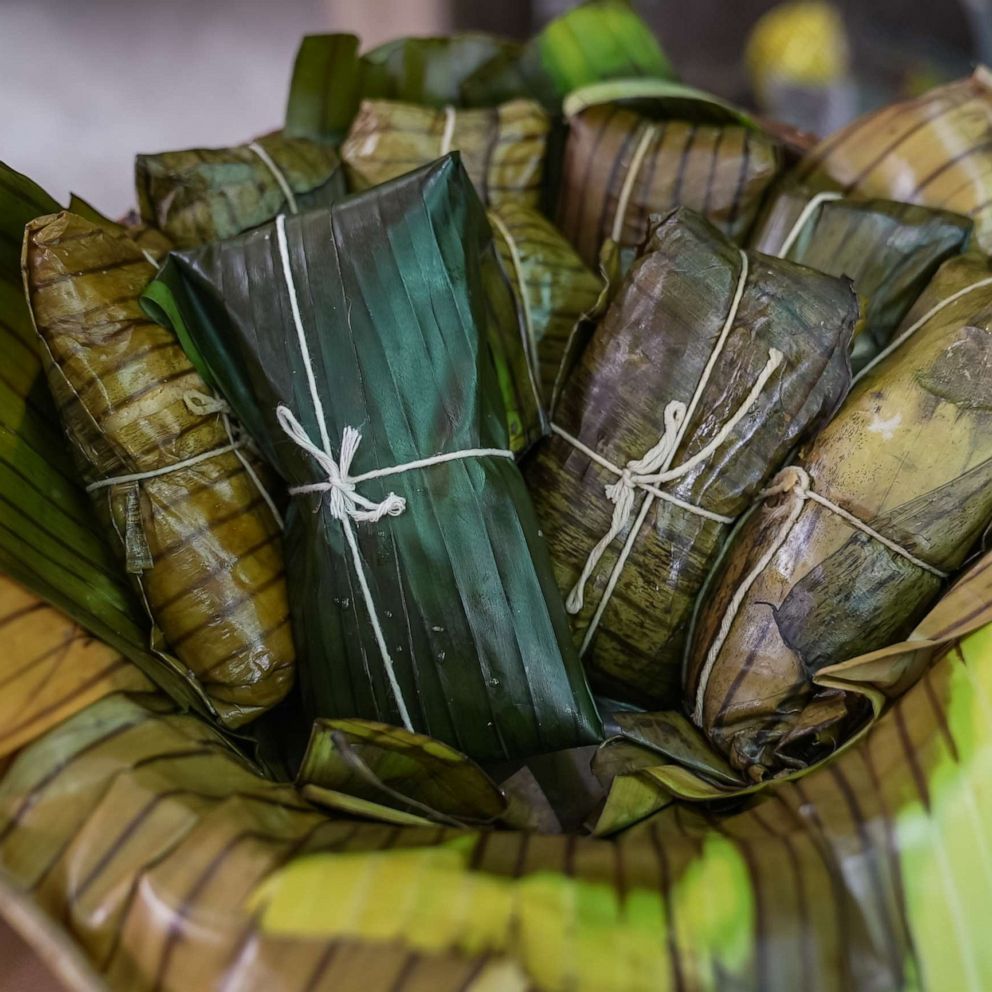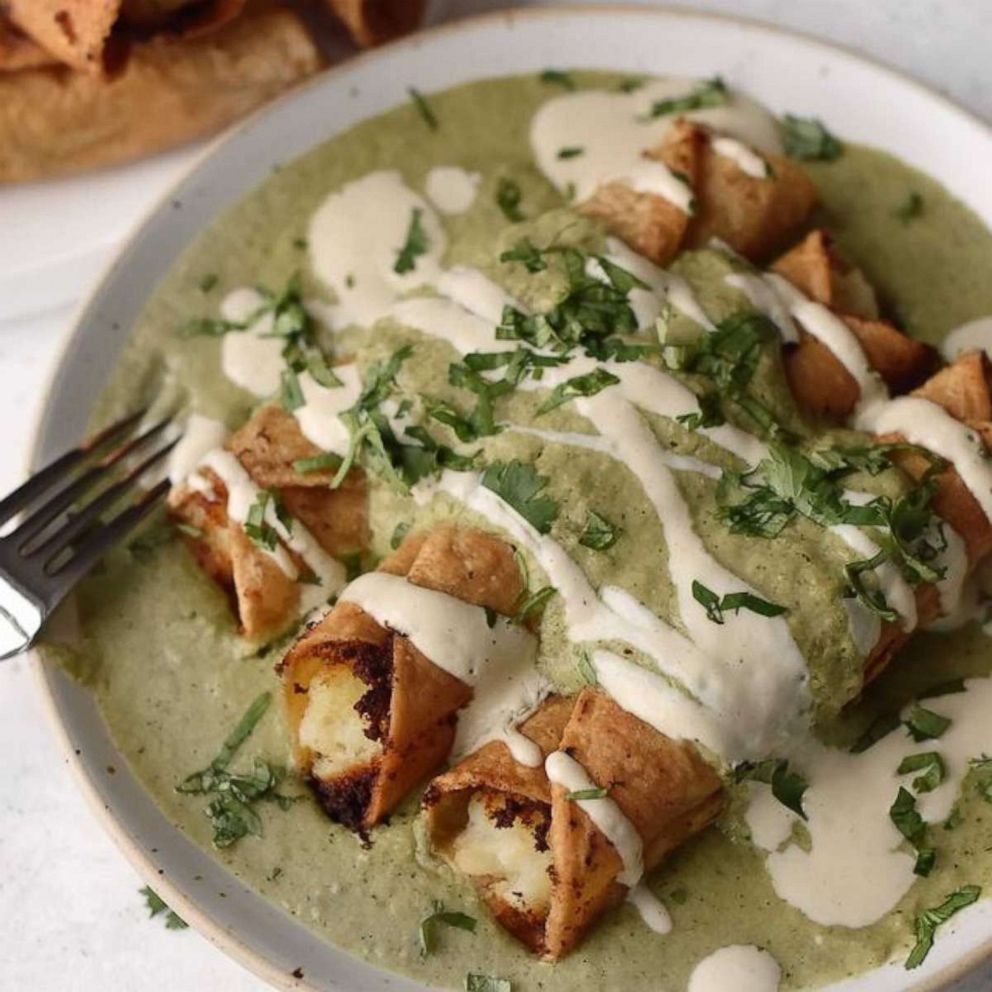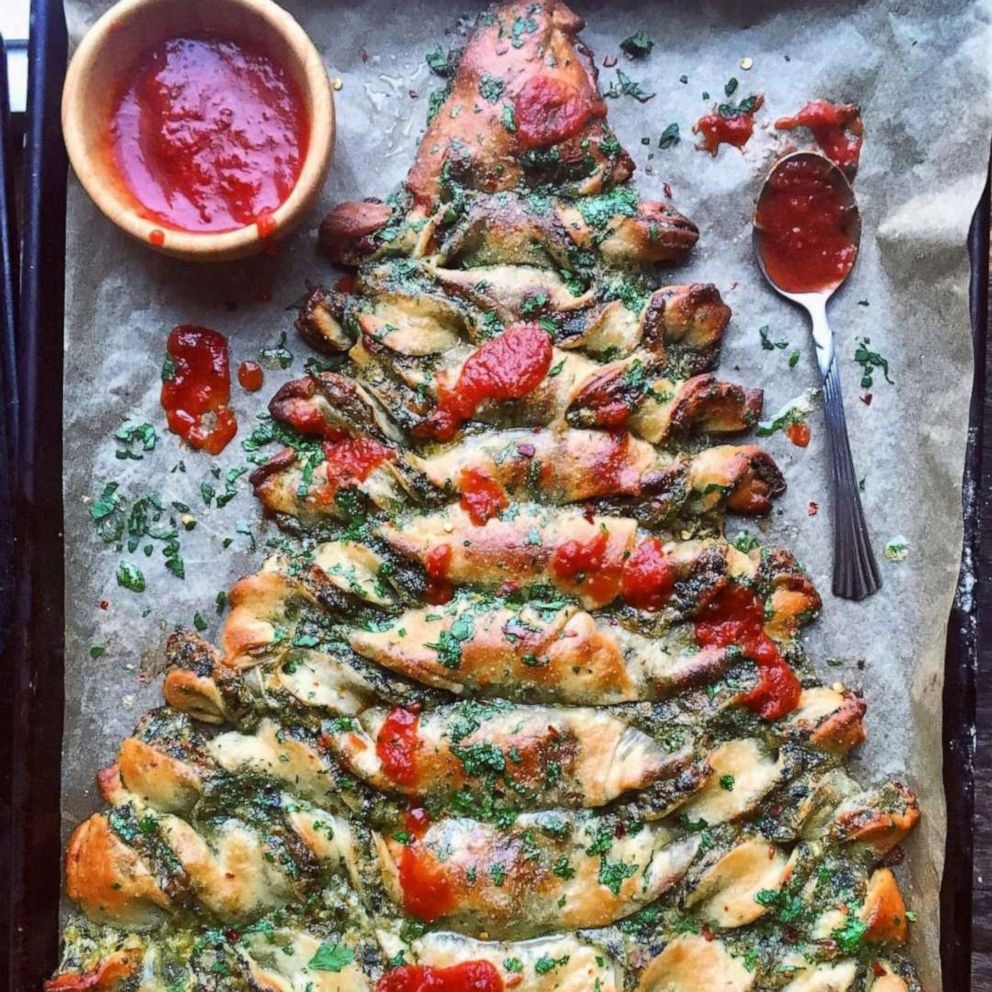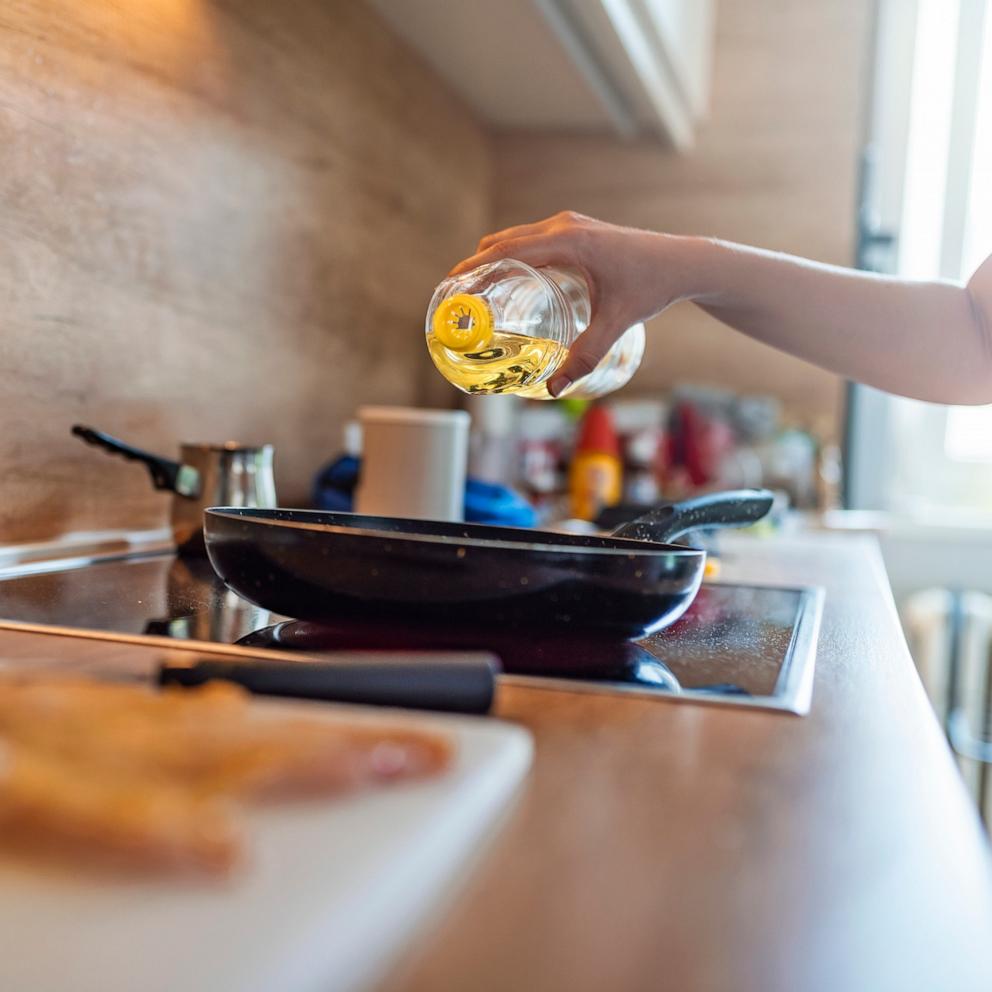Recipes that celebrate the purest expression of heirloom corn sourced from Mexico
After years working under some of the most influential culinary names in New York City, Jorge Gaviria found a way to reconnect with his Latin roots while preserving the traditions of farmers producing one of Latin cooking's staple ingredients.
"Masa is really at the center of all Latin cuisine, it's the connective staple," Gaviria told "Good Morning America" about Mexican corn, which was first domesticated by indigenous peoples of Mesoamerica thousands of years ago. "It seemed like a really smart place to start because of its potential, its mass appeal -- and what's fun to me is it's a staple we all really love but no one knew very much about it, very much like oral tradition."
Gaviria said his hope was to retell the story of masa "with a modern take but with traditional wisdom behind it" and find a way to build a product and business around it that looked out for the farmers and the land it comes from.
In 2014, his vision took shape with Masienda, an heirloom corn purveyor that became a go-to kernel to masa program for chefs almost overnight, and has since grown to include a direct-to-consumer space for home cooks as well.

"The more I was sort of spending time and reflecting on my experiences, the more I realized that the foods that I was creating, selling, storytelling, had very little relationship with the foods I grew up eating," Gaviria said. "This kind of ethos and philosophy was kind of absent from the staples that define my Latin community that I grew up in in Miami, and my family. I had a longing to reconnect with that in a deeper way and to explore the potential going back to my roots, and in some ways improving upon what I grew up with -- or doing it in a thoughtful way."
Gaviria said that from a young age -- he was born to a Mexican and a Cuban father living in Miami -- "I was influenced by so many Latin cultures. But I grew up eating convenience food. Every tortilla I probably ate was made with maseca [corn flour]" versus authentic masa harina.
From the start Gaviria also recognized that Masienda could have "a huge economic, social and environmental impact if we built the supply chain out of Mexico." The business began with 12 farms in Oaxaca and focuses its efforts in mostly indigenous communities. "As we've gained trust and proof of concept in communities," Gaviria said, they've expanded to additional regions of Mexico to continue producing responsibly grown, non-GMO ingredients in their authentic varietals.
"This is where kind of the world's genetic supply of heirloom corn is focused -- it's the highest quality corn in the world," he said. "These are folks who have been maintaining regenerative practices for centuries -- it's built into the agricultural tradition of the milpa [a sustainable farming system]."
Masienda also found a way to help farmers make money off corn that was not being treated as cash crops. "They weren't growing for commercial gain. If they had a surplus, they would lose it. This was a chance for them to have that that inventory absorbed at a really, really high price."
In Mexico, Gaviria said, "You've got such a wide array of flavors and textures to choose from" -- unlike the commercial agriculture that has industrialized corn and "bred out the things that make corn special."

Gaviria initially poured his years of research and work with chefs on creating masa in their kitchens into a self-published booklet that sold thousands of copies. This month, his highly-anticipated book, "Masa: Techniques, Recipes, and Reflections on a Timeless Staple," finally hit shelves in its full glory.
"All the cookbooks that had something to say about [masa], it was only like a page or two about how to do this process -- but that was like fitting thousands of years of tradition into like two pages," he said.
While the book spans everything from transforming the heirloom ingredient into traditional, well-known recipes like tortillas, Gaviria also explores other uses and shapes that both chefs and home cooks alike can enjoy.
"This book scratches that chef itch, but it is definitely designed with my in-laws in mind who are decidedly not chefs," Gaviria said with a laugh. "I try to make sure that everybody from a professional chef to home cooks felt represented and seen in this book and had something to learn to take away so you don't need to be intimidated."
Check out the baseline recipe below to create tortillas and other shapes, plus a unique Mexican riff on a hot dog using the heirloom corn.
Table Tortilla Masa

Makes 2.2 pounds of masa or (about thirty-five 5-inch tortillas)
Ingredients
1 pound [455 grams] dry field corn
1/6 ounce [4.5 grams] food-grade calcium hydroxide (1% of total weight of corn)
Warm water
Directions
Rinse the corn in a colander to remove any debris or chaff.
Place the calcium hydroxide in a medium nonreactive mixing bowl and slowly incorporate warm water, stirring until the mix becomes a loose, smooth, and uniform slurry.
Pour the corn into a large nonreactive pot and add the calcium hydroxide mixture directly into the pot. Add just enough water to cover the corn by 4 inches [10 centimeters] and stir everything together with a spatula to evenly incorporate.
Cover the pot (optional; however, it helps to get to temperature faster) and place over high heat. Bring to a boil, then lower the heat to medium for a simmer. Using a fine-mesh sieve, skim any unwanted kernels or particles that float to the surface and discard.
Stirring frequently so the corn doesn't scorch at the bottom of the pot, set a timer and check the corn every 5 minutes for the following variables: Remove a kernel and rub it between your fingers. If the skin easily slides off (I mean easily), we're nearly there. Taste a kernel. When it's ready, it will be tender, but al dente (like a boiled peanut or roasted cashew) and have a distinct tortilla flavor. The skins' loosening and the texture and flavor development should take anywhere from 10 to 45 minutes, depending on the corn's moisture content and density.
Continue cooking, if necessary, checking every 5 minutes, until the skins are loosened and you have reached the desired texture and flavor. Remove from the heat and cover the pot. Let the pot sit undisturbed for 6 to 12 hours.
Drain the steeped corn, now called nixtamal, into a colander. Rinse, massage, and agitate the nixtamal vigorously until it has reached your desired percentage of skin wash-off (I recommend about 50%, to start).
Grind the rinsed nixtamal. For a table tortilla masa, we want as fine a grind as possible—if you were to rub the masa between your fingers, the absolute ideal would be to feel no particles whatsoever.
Mix the masa manually or using a stand mixer with a dough hook attachment for 2 to 3 minutes, slowly adding water as needed, until the masa is as wet to the touch as possible without being sticky (that is, clumps should not easily stick to your hand). Perform the smush test. Adjust the water as necessary until no cracking occurs.
The "smush" test
To test the masa for the right level of moisture, roll a ping-pong-size ball (about 1 1/2 inches or 4 centimeters) and flatten it between the palms of your hands. If the edges of the flattened masa are cracking, add more water until it passes the same test without cracking. (The ideal texture is moist but not sticky, pliable but not gummy.) Once it does, you're ready to get into tortilla pressing.
Storage: Table tortilla masa contains 57 to 70% moisture, which means that it will ferment quickly at ambient temperatures. While I always prefer to use fresh masa immediately, you may choose to store it in the refrigerator for up to 3 days or in the freezer for up to 3 months. Bear in mind, however, that refrigerated or frozen masa will lose some elasticity over time, and you will most likely need to reincorporate additional moisture into the masa and mix it before use. If you are storing your masa at room temperature, I recommend holding for no longer than 4 hours. Even then, you may need to reincorporate a bit of moisture, as water will have evaporated from the masa, drying it out.
Preparing Table Tortilla Masa Using Masa Harina
If using masa harina, 1 pound of dry masa harina should yield 2 to 2 1/2 pounds of wet masa.
By weight, you can assume the ratio of 1 part masa harina to 1.4 parts water. If you do not have a scale, 1 packed cup of masa harina requires about 1 scant cup [237 ml] of water (by volume). One packed cup of dry masa harina should yield about ten 5-inch [15-centimeter] tortillas. Not all brands are created equal, so you may need to adjust ratios accordingly.
Slowly add the water to the dry masa harina in a large bowl, stirring the masa to incorporate evenly by hand (you may also choose to use a stand mixer fitted with a dough hook). Knead until the water is evenly incorporated and no dry, powdery spots remain. You'll want a finished masa that is moist to the touch, but not sticky.
Once prepared, use immediately, or rehydrate with additional water before use (if it's been more than a few minutes).
Pressing the table tortilla
Preheat a comal to medium-low heat. Open the tortilla press. Lay a plastic liner squarely on the surface of the press. Break off about 2 tablespoons of fresh masa (or whichever size you prefer) and roll the masa into a ping-pong-size ball (about 1 1/2 inches) with your hands. Place the masa ball in the center of the plastic liner; to end up with a centered tortilla in the press, it sometimes helps to place the masa ball about 1 inch (2.5 centimeters) from the center, closer to the press's hinge/pivot point. Place a second plastic liner on top of the masa ball.
With the top half of your fingers, slightly flatten the masa until it begins to adhere to the plastic liners (this prevents the masa from shifting around when you close the press).
Close the tortilla press lid and apply pressure by pushing down on the lever. Open the tortilla press lid and remove the flattened masa/uncooked tortilla. (You may first choose to flip the tortilla and press a bit more, if the tortilla is not as thin as you'd like. I like them to be about 1/16 inch [1.5 millimeters].)
For a decorative flourish, you can press flat herbs and flowers into the face of the tortilla at this stage. After the initial pressing, open the tortilla press lid, remove the top plastic liner, and place your herbs or flowers (for example, cilantro flower, hoja santa, tarragon) across the face of the tortilla (see photo above). Place the top plastic liner across the face of the tortilla (sealing in the herbs and/or flowers), close, and lightly press. Your garnish should now be nicely pressed into the tortilla.
Carefully peel away one plastic liner at a time. It helps to hold the tortilla face up (flat in your hand) and first carefully peel off the top liner; then, pinching one of the outer edges/corners of the plastic, flip the uncooked tortilla over to your opposing hand (the tortilla should now be directly touching your open-faced, opposing hand, ideally your pinky through middle fingers for best stability) and peel off the second plastic liner off.
Cooking the table tortilla
Raise the temperature of your preheated comal to medium heat. In a smooth, backhanded sweeping motion, place the uncooked tortilla directly on the nonstick surface. I prefer to put it directly onto the clean, dry surface; however, you can oil it if you prefer. Sear the first side for 20 to 30 seconds. I recommend using a timer, especially as you get a feel for your pan and the overall process. The hotter the temperature, the less time will be needed per side (even as little as 15 seconds, depending on how high the temperature is). The sear should yield a surface with even, light-colored spotting throughout. Flip and sear on the second side for another 20 to 30 seconds. Finally, flip the tortilla to its original seared side, allowing it to continue cooking through the center to your desired consistency and doneness. Play with sear times as you see fit.
I prefer table tortillas cooked to a medium internal moisture/doneness that passes the crumple test -- that is, moist but not doughy and slightly molten on the inside, with a nice exterior crust. Even if you don't love a crust, keep in mind that this crust will soften quite a bit from steam if the tortilla is stacked in a pile and wrapped before serving. To reach this state, ideally the tortilla will have puffed during the cooking process.
Tetela

This shape cooked on a comal is described in the book as "a stuffed, sealed triangular envelope that loosely resembles a small crêpe."
"Some folks frown upon sort of making these comparisons -- but I think it's a helpful way to relate if you don't know it and you're intimidated by the word," he said, explaining "it's basically like a crepe. It's a tortilla into a triangle and has a stuffing inside of it."
He added, "you can literally put anything in it -- it may be my favorite shape in the chapter."
Directions
Preheat the comal to medium-high heat. Roll a ping-pong-size ball (about 1 1/2 inches of Table Tortilla Masa (recipe above). Following instructions for a Table Tortilla, press the ball into a tortilla, remove the top plastic liner, and spread a bit of filling across the center. To shape the tetela, with the plastic liner squared as you face the tortilla, lift the top right corner of the plastic and fold it with the right edge of the tortilla to a 45-degree angle, creating a pointed tip at the top of the tortilla. Repeat on the left side. Finally, grasp the lower center of the plastic liner and fold the remaining flap over to create a well-defined, straight-edged triangle.
There should be little to no exposure of the filling through the seams, ensuring that the contents are well enclosed.
Lower the comal to medium heat. Place the tetela seam-side up on the comal. Cook for 4 to 6 minutes per side, until cooked through the center with a slight char on each side. You can test for doneness with a cake tester, if you'd like, though I prefer testing by feel. When pressed down, the tetela shouldn't give or bounce much -- it should feel like a well-done steak, indicating a dense interior. I love a tetela with a chewy, crispy crust (sometimes called bark) with a contrasting molten center.
No extra fat is needed to cook a tetela, but a little bit applied directly to the tetela toward the last minute of cooking is never something I regret. I'll use whatever I have around, from bacon fat to schmaltz to ghee. These are best served warm.
Storage: A fresh-cooked tetela is best enjoyed immediately, but can be stored (without toppings) for up to 7 days refrigerated or 1 year frozen. A little bit of water rubbed on either side of the tetela will help replenish any moisture lost during storage, prior to reheating on a comal.
Masa Corn Dog with Huitlacoche "Mustard"

"Having trained under molecular gastronomy legends Grant Achatz and Wylie Dufresne, Alex Stupak was a young pastry prodigy before applying his talents to masa at Empellón in New York City," the recipe's intro states. "Alex has a deep devotion to Mexican cuisine, but he's not afraid to mash up traditional techniques with modern flavors, as in these Masa Corn Dogs. Huitlacoche, also known as cuitlacoche, corn truffle, or corn smut, is best when fresh. Because fresh huitlacoche only lasts about 7 to 10 days refrigerated, it can be difficult to find. It will usually be located in the refrigerated area of the produce section of your local Latin grocer. If you are unable to find fresh huitlacoche, canned huitlacoche may be substituted here. Just make sure to strain out all of the canning liquid before use. Canned huitlacoche is available online and at most Latin grocers."
Huitlacoche Mustard1 tablespoon olive oil
3 tablespoons finely chopped onion
2 large garlic cloves, finely chopped
1 small serrano pepper, seeded, deveined, and finely chopped
1 medium tomato, roughly chopped
7 ounces [200 g] fresh huitlacoche or a 7-ounce [198-gram] can huitlacoche (corn smut), rinsed and drained
1/3 cup, plus 1 tablespoon [100 grams] Dijon mustard
2 teaspoons mezcal
1/2 teaspoon sugar
1/2 teaspoon MSG
1/4 teaspoon fish sauce
For the corn dogs
1 pound [455 grams] Table Tortilla Masa
About 1 cup [240 milliliters] milk
1 large egg
1 teaspoon fine salt
3 tablespoons all-purpose flour
1 teaspoon baking powder
1 teaspoon calcium hydroxide (lime)
2 quarts [1.9 liters] vegetable oil, for frying 8 hot dogs
Chili salt
Lime wedges, for serving
Directions
To make the huitlacoche mustard: Heat the olive oil in a medium sauté pan over medium-low heat. Add the onion, garlic, and serrano pepper and cook until softened, 3 to 5 minutes. Add the tomato and cook, stirring and raising the heat to medium as needed, to release and then evaporate the juices, about 5 minutes. Add the huitlacoche and cook until its juices have released and evaporated, 3 to 5 minutes more. Transfer to a blender. Add the Dijon mustard, mezcal, sugar, MSG, and fish sauce, and purée on high speed until smooth. Transfer to a bowl and set aside.
To make the corn dogs: Crumble the masa into a blender. Add the milk, egg, and salt, and purée on high speed until combined. Transfer to a large bowl. Fold in the flour, baking powder, and calcium hydroxide until just combined. (The mixture will thicken a bit as it sits.) Let rest for 5 minutes and use immediately thereafter.
In a pot that's 2 inches [5 centimeters] wider than the skewers, heat 3 inches [7.5 centimeters] of oil to 350 F [180 C]. Insert a skewer lengthwise through the center of each hot dog, leaving 1 inch [2.5 centimeters] or so of skewer exposed at the end.
Fill a pint glass with the batter. Submerge a hot dog into the batter, coating it all over. Fry one or two hot dogs at a time, depending on the size of your pot, until golden brown, 4 to 5 minutes. Let drain on a wire rack or paper towel–lined plate. Season with chili salt. Repeat until all the hot dogs are fried. Serve the corn dogs with lime wedges and the huitlacoche mustard on the side.
Reprinted with permission from MASA: Techniques, Recipes, and Reflections on a Timeless Staple, © 2022. Published by Chronicle Books. Photographs © Graydon Herriott.







